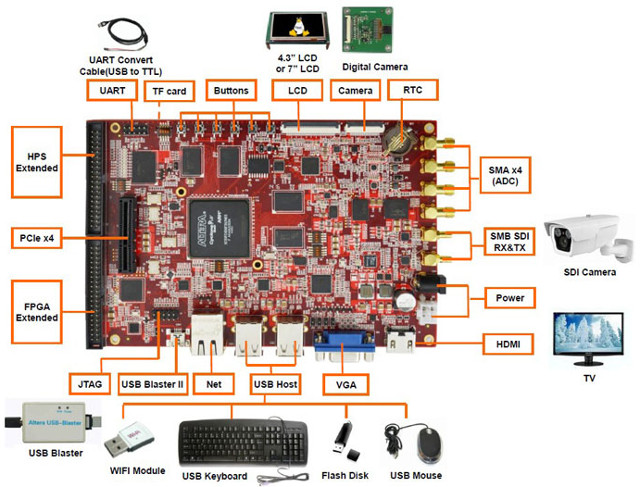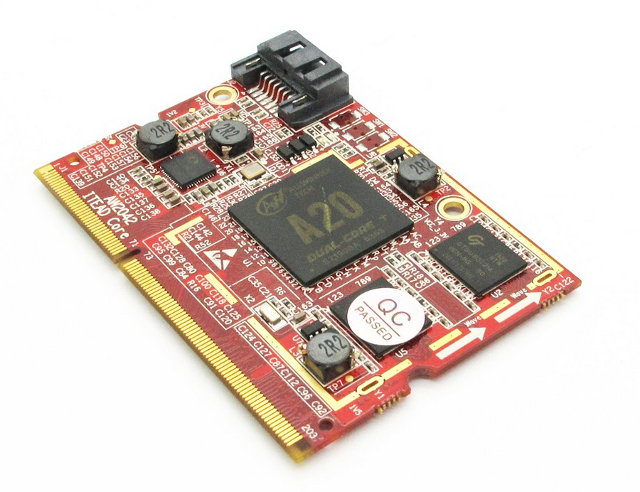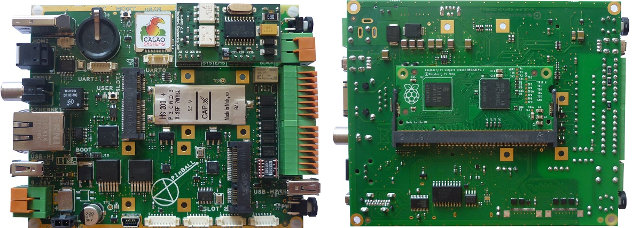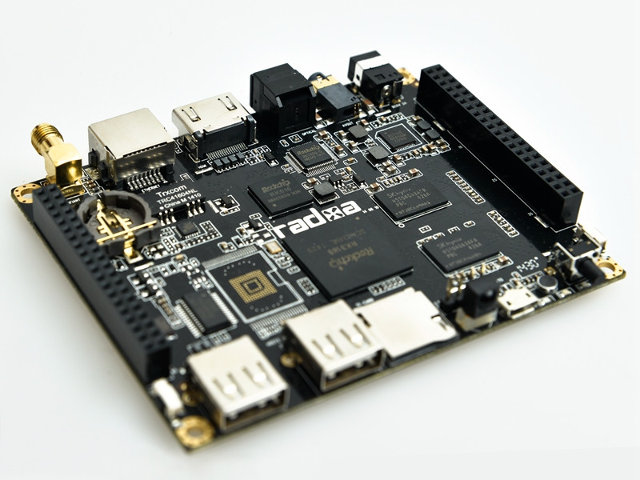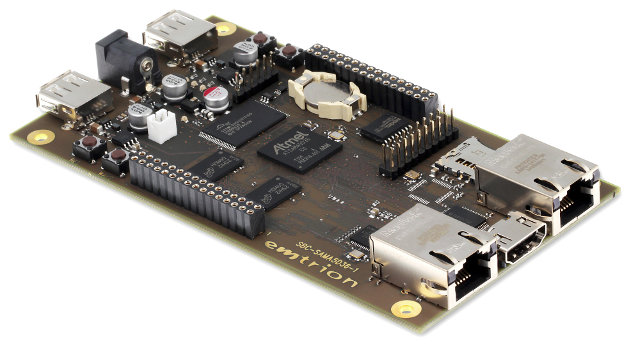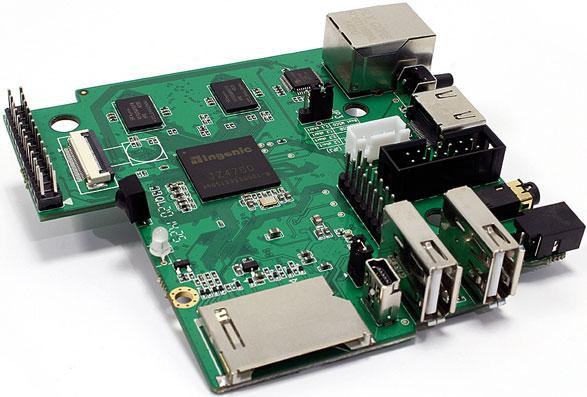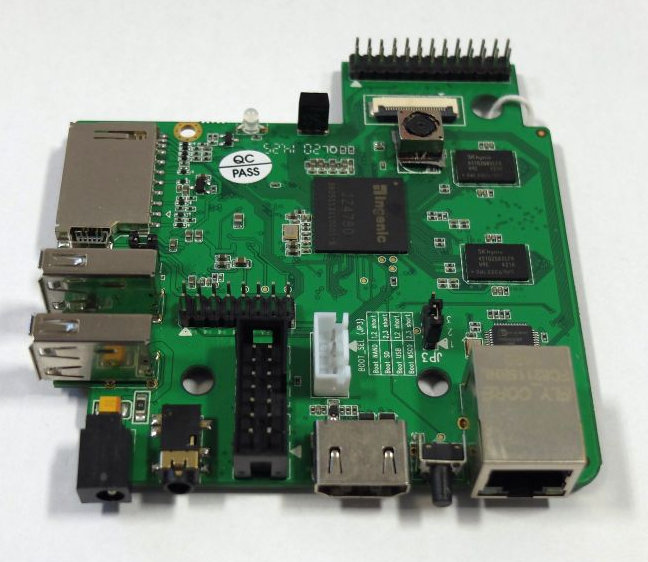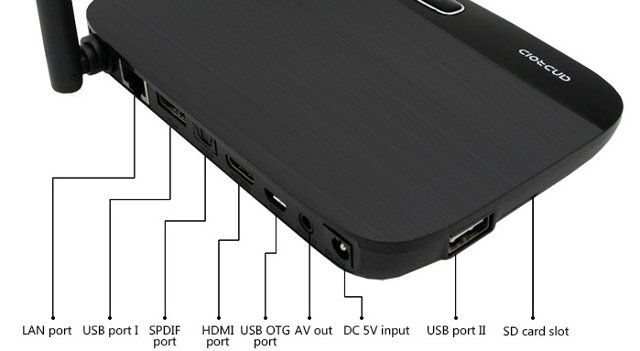Farnell/Element14 has quietly announced Lark Board from their subsidiary Embest Technology in September. The board is powered by an Altera Cyclone V ARM Cortex-A9 dual-core + FPGA processor with high speed transceivers, runs Debian 7.4, and targets medical instruments, video surveillance and industrial control applications. Lark board specifications: SoC – Altera Cyclone V SX (5CSXFC6D6F31I7N) with a dual core Cortex A9 processor (HPS – Hard Processor System) @ 800 MHz, FPGA fabric including up to 110K logic cells (LE), and high speed transceivers (2 PCIe hard IPs and 9 3Gbps transceivers) System Memory – 1GB DDR3 SDRAM for HPS, 1GB DDR3 SDRAM for FPGA Storage – 4GB eMMC Flash + micro SD card slot Audio/Video Interfaces – HDMI, VGA, and 24-bit LCD interface supporting 4-wire touch screen Data Transfer Interfaces: High-resolution serial digital interface (SDI) that supports SMD standard interface and provides a SDI TX and a SDI RX 12-bit […]
ITEAD Core AW204X AllWinner A20 SoM and Core EVB Baseboard
ITEAD Studio has been making systems-on-module based on Allwinner processors for a little while which are found in the company’s IBOX mini PC, MOD Duo guitar pedal, and more. They’ve now launched a new system-on-module with a 204-pin SO-DIMM connector instead of the headers used in the earlier modules. ITEAD Core AW2041 / AW2042 SoM specifications: SoC- AllWinner A20 dual core ARM Cortex-A7 @ 1 GHz + ARM Mali 400 MP2 System Memory – 1 or 2 GB DDR3 RAM (AW2014: 1GB, AW2042: 2GB). Storage – 4GB NAND Flash, micro SD card slot (on the back), SATA connector. Connector – 204-pin SO-DIMM edge connector with UART, I2C, SPI, LCD, I2S, LVDS, GPIO, etc.. signals Misc – Built-in RTC, reset, FEL and power buttons. Power – 5V supply, 3.3V I/Os. AXP209 PMIC. Dimensions – 67.60 x 48.25 x 1.6 mm Weight – 35 grams Temperature Range – Commercial To facilitate development, the […]
CALAO Systems Introduces PInBALL Industrial Board Based on Raspberry Pi Compute Module
CALAO Systems has just launched an industrial single board computer (SBC) for professional Raspberry Pi developers called PiNBALL or, if you prefer, PAC-1210-S200-B2835-EXX…. The board is powered by the Raspberry Pi Compute Module, features interfaces such as two mini PCIe slots (for USB, I2C, GPIOs,…), fast Ethernet, HDMI, opto-isolated inputs and outputs, etc., +6 to +36V power input, and can operate in -20°C to +70°C temperature range. PInBALL industrial SBC specifications (Items marker with ‘*’ are optional, and depend on model): SoC / Memory / Storage – Via Raspberry Pi Compute Module – Broadcom BCM2835, 512MB RAM, 4GB eMMC Flash. Other Storage – 1x 2Kb I²C EEPROM with EUI-48 MAC Address & 128 bit Serial Number (AT24MAC402). Video Output – 1x HDMI Out, 1x CVBS Out (BCM2835) Audio Output – 1x HDMI, 2x S/PDIF Out / Optical & RCA (WM8804), Connectivity – 1x Fast Ethernet (LAN9514), 1x Micro-SIM Socket USB […]
The New Radxa Rock Lite Rockchip RK3188 Development Board Sells for $59
You may have heard about Radxa Rock Lite development board before, so let’s clear up the different versions of the Radxa Rock first. There’s a total of four Radxa Rock models: Radxa Rock (2013) – The original version with 2GB RAM, 8GB NAND Flash, and Wi-Fi/Bluetooth Radxa Rock Lite (2013) – 1GB RAM, 4GB NAND Flash, and Wi-Fi only Radxa Rock Pro (2014) – An evolution of the Radxa Rock still with 2GB RAM, 8GB NAND flash, Wi-Fi/Bluetooth but adding LVDS and camera interfaces. Radxa Rock Lite (2014) – 1GB RAM, no NAND flash, and Wi-Fi only The fist two versions appear to have been phased out, as they are not listed for sale on Radxa Rock website, and today, I’ll write about Radxa Rock Lite (2014). Radxa Rock Lite (2014) specifications: SoC – Rockchip RK3188 ARM Cortex-A9 quad core @ 1.6Ghz + Mali-400 MP4 GPU System Memory – 1GB […]
Emtrion SBC-SAMA5D36 ARM Cortex A5 Linux Development Board Comes with Dual Ethernet, HDMI Output
A few months ago, I reviewed Atmel Xplained SAMA5D3 development board powered by SAMA5D36 Cortex A5 processor. The kit is supported by the Yocto Project, so I could build and run Poky distribution with a recent Linux kernel (it support mainline), it features Arduino compatible headers, and I found the board to be a nice platform for headless applications, or applications that require an LCD display. However, if you wanted to connect an HDMI display you’d be out of luck, unless you design your own LCD to HDMI add-on board. Emtrion SBC-SAMA5D36 could be an interesting alternative, as it features very similar specifications, but adds an HDMI output port. Emtrion SBC-SAMA5D36 specifications: MPU – Atmel SAMA5D36 single core Cortex-A5 @ 536 MHz System Memory – 256 MB RAM Storage – 512 MB NAND Flash, up to 16 MB NOR Flash, and micro SD Card socket Connectivity – 100Base-TX Ethernet, 10/100/1000Base-TX […]
MIPS Creator CI20 Development Board Formally Announced, Free to Selected Developers
Earlier this month, I discovered MIPS Creator CI20 development board based on Ingenic JZ4780 dual core MIPS processor thanks to one of my reader. Imagination Technologies has now launched the board, which will run Debian 7 first, soon support Android 4.4 and others Linux distributions, and the company places their MIPS board as a competitor to the popular ARM based boards such as the Raspberry Pi and BeagleBone Black. This is the first board part of Prpl initiative for open source Linux and Android software for the MIPS architecture. As a reminder, I’ll list the hardware specifications again: SoC – Ingenic JZ4780 dual core MIPS32 processor @ 1.2 GHz with Imagination PowerVR SGX540 GPU. 32kI + 32kD per core, 512K shared L2. System Memory – 1GB DDR3 Storage – 8GB NOR flash, 1x SD card slot, 1x SD card slot via expansion Video Output – HDMI up to 1080p Audio […]
MIPS Creator CI20 Development Board Powered by Ingenic JZ4780 SoC
There are plenty of ARM based development boards running Linux and Android, but with MIPS it’s a different story. Microchip does have some affordable development board powered by their MIPS MCUs, but these don’t have the hardware specs to run Linux based operating systems, and Ingenic Newton Platform for wearables can run Android and Linux, but it appears to be reversed to companies with virtual no documentation. There are some MIPS platform running OpenWRT on hardware such as routers or Wi-Fi boards, but these can’t be considered fully supported development boards. But Imagination Technologies is trying to make MIPS more relevant, first by launching Prpl developers’ community, and MIPS Creator CI20 development board powered by Ingenic JZ4780 dual core MIPS32 (Xburst) core processor with PowerVR SGX540 GPU should soon be available with complete documentation and source code. Let’s go through the hardware specifications first: SoC – Ingenic JZ4780 dual core […]
Dual Core VolksPC Android and Debian Mini PC Gets Crowdfunded
Last months, I tested VolksPC’s Android/Debian unified distribution on MK808 mini PC, which runs both operating systems at the same time, and allows you to switch instantaneously and seamlessly between the two. I was impressed by the performance and stability of the system, although there were still a few software bugs, as well as issues related to MK808 hardware (Wi-Fi disconnection), and possibly its 5V/1A power supply (system reboot when inserting SD card reader or flash drive). The company has now started a crowd-funding campaign on Indiegogo to manufacture dual core Android TV box with their unified distribution. VolksPC specifications: SoC – Rockchip RK3066 dual core ARM Cortex-A9 processor @ 1.4Ghz with Mali-400MP4 GPU System Memory – 1GB DDR3 Storage – 8 GB NAND Flash (for Android), 8GB MicroSD card (Debian Wheezy) Video Output – HDMI 1.3, AV jack Audio Output, HDMI, AV jack, and optical S/PDIF Connectivity – 10/100M […]


